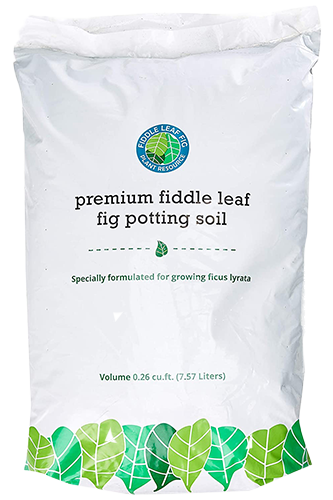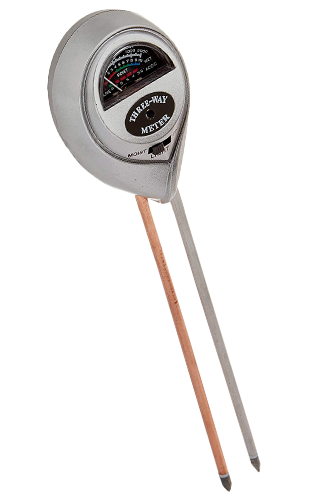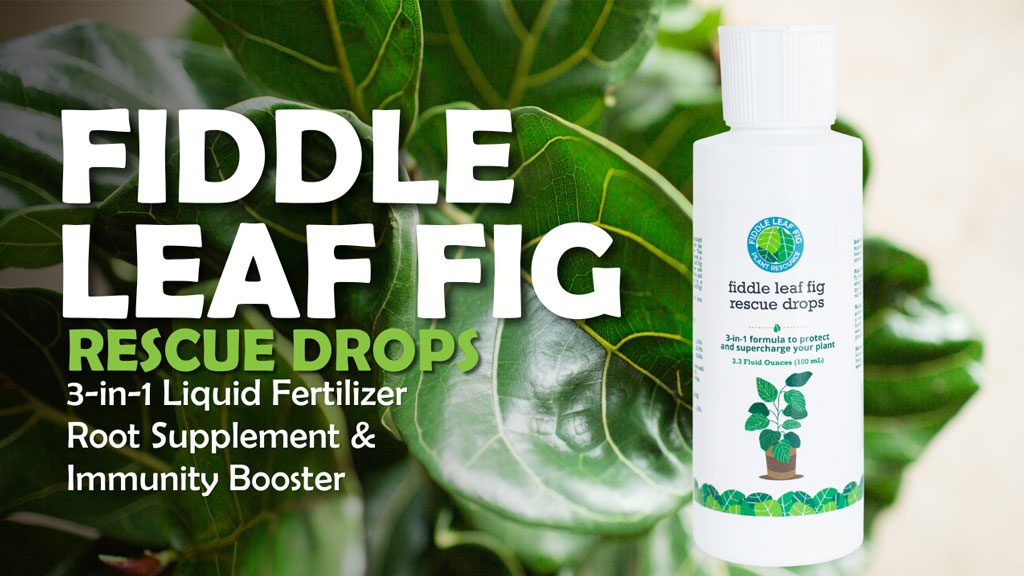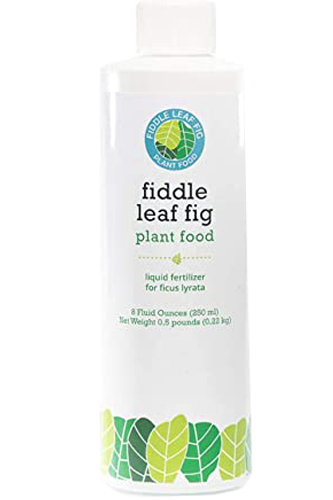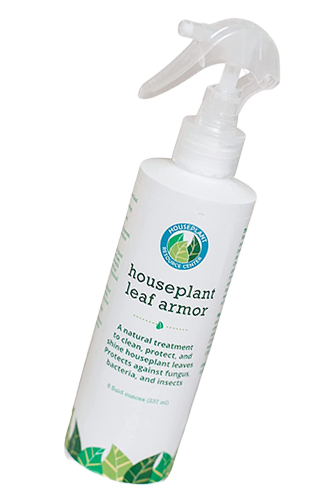Ficus Benjamina Care | Weeping Fig Tree
Around here, we’re all big fans of the beautiful Ficus lyrata, or fiddle leaf fig! As a fan of all things ficus, I was excited to learn about the return of a tree you’ve probably seen before: Ficus benjamina, or the weeping fig.
You’ve probably seen these before, as they were extremely popular during the ’70s and ’80s (so much so that they’re often just called a ficus tree), but they’re making a comeback! They’re a beautiful plant to add to your collection.
Native to tropical and subtropical regions of Southeast Asia and Australia, Ficus benjamina can reach up to 60 feet outdoors, but indoors they’re usually pruned to 3-6 feet. Their trunks can be braided together for a fun woven look, and these trees are also excellent at cleaning the air in your home.
What Is a Ficus?
If you’re new to ficus trees in general, here’s what you need to know about this family of trees.
“Ficus” is the name of a genus that includes about 850 species of trees, vines, and shrubs in the Moraceae (or mulberry) family. Ficuses, which include many fig trees and the rubber tree, have long been kept as potted houseplants.
These trees are typically tropical plants and love plenty of light and a moderate amount of water. With a little practice, ficuses can become your new houseplant obsession! There are lots of different varieties to choose from, from the whimsical fiddle leaf fig with its huge, lyre-shaped leaves, to Ficus benjamina with its small, slender leaves that many find to be a more refined, approachable alternative to the bold rubber tree or the sophisticated (and pricey) Ficus audrey.
Benjamina Ficus Tree Care
The good news about Ficus benjamina is that they enjoy similar conditions as Ficus lyrata. So if you’re able to care for fiddle leaf figs in your home, you’ll probably do well with weeping figs as well!
Potting and Soil
Use a pot that’s one size or 2-3 inches larger than your ficus’s root ball. Make sure the pot drains well! Plant your tree in a light, well-aerated soil like our Premium Fiddle Leaf Fig Soil, which works beautifully for all species of ficus.
Light
Ficus benjamina, like most species of ficus, appreciates lots of bright, indirect sunlight.
An east-facing window that gets bright morning light is the perfect spot for your Ficus benjamina. You can also place your tree a few feet away from a west- or south-facing window where the harsh afternoon sun won’t shine directly on the leaves. (Too much direct sunlight can scorch your weeping fig’s leaves if it’s not acclimated to full sun.)
A north-facing window may not provide enough light for a ficus, but you can always supplement with a grow light if your space doesn’t have enough natural light for your plant.
Temperature
Ficus benjamina does NOT like to be cold.
A Ficus benjamina will be happy between 70 and 85 degrees Fahrenheit, but it’s okay for nighttime temps to drop as low as 65 degrees. Keep your ficus away from drafts, vents, heaters, or fireplaces that can either freeze or scorch the leaves. In the winter, you may also want to set your plant on a block of wood or Styrofoam to insulate the root ball.
As a tropical plant, your weeping fig prefers at least 40% humidity. If your fig’s leaves look healthy, your tree might be just fine, but it’s never a bad idea to set up a humidifier nearby or group your tree with other plants for a little more ambient humidity from their respiration.
If you notice the tips of your weeping fig’s leaves drying out and turning brown, your tree might want a little extra humidity.
Ficus Tree Watering
Ficus benjamina does best with moderate water, which means you should water when the top 2-3 inches of soil feel dry or when a moisture meter reads 3-4. I highly recommend using a moisture meter because it gives you a much better idea of what’s happening inside the root ball. After all, if the soil is compacted or draining poorly, the top few inches might feel dry while the root ball is actually soaked! A moisture meter can prevent issues with over- and underwatering.
Here’s the one I use and recommend.
To take a measurement in the middle of the root ball, insert the sensor into the soil about halfway between the base of the plant and the edge of the pot, and about halfway down.
When it’s time to water, add-room temperature water to the soil until it just starts to drain out the bottom of the pot, then empty the drainage tray immediately.
You should be watering every 7-14 days. If your soil dries out too soon, you may not be watering deeply enough. If the soil still feels wet after two weeks, your soil or pot may not drain well enough, or your tree might not get enough light.
Ficus Tree Pruning
Ficus trees grow fairly quickly, so you need to prune your Ficus benjamina from time to time to keep it to a manageable size! These trees also tend to grow toward the light. Rotating with each watering can help this, but if your tree is starting to get off balance, pruning can help. Simply cut a branch or two at once to balance your tree out.
Tip: If you’re pruning to control your Ficus benjamina’s size, do it in the winter when the tree isn’t actively growing.
If you notice any dried-out or diseased leaves or branches, you can prune those at any time of year.
How to Prune a Ficus Tree
When you’re preparing to prune your ficus, make sure to plan your cuts in advance so you don’t accidentally prune too much! Try marking the branches you plan to remove with pieces of colored strings or tape.
When you’re ready to prune, use sterilized shears and gloves to prevent potentially spreading pathogens around the tree. You may also want to put down paper or a tarp, because your Ficus benjamina may bleed sap that can damage flooring! This sap is also irritating to your skin, so gloves are a good idea. You might also want to have a clean towel handy to catch this sap.
When you’ve gathered your equipment and have planned your cuts, prune the branches you planned to prune and give your tree time to rest and recover.
Ficus Tree Roots and When to Repot
Ficus trees, including Ficus benjamina, tend to have robust root systems. You might notice roots sticking out of the top of the soil in your pot, but this doesn’t necessarily mean your tree needs to be repotted.
Your weeping fig will outgrow its container every year or so, so plan on repotting annually. If you notice roots growing around the inside of the pot in a circle, coming out of the bottom of the pot, or if the soil becomes hard and compacted, you may need to repot early.
When you do repot, go up a pot size and find a pot that’s 2-3 inches larger than the root ball. While it’s tempting to use a much bigger pot to give your tree more room to grow, this can actually lead to overwatering issues because the pot may hold more water than the tree can actually use.
Ficus Fertilizer
In nature, fig trees receive all the nutrients they need from their soil, which is constantly fortified by organic matter that continually breaks down and enriches the soil.
Potted plants, like your weeping fig, can use up all the nutrients present in their potting mix in just a few months, so it’s important to supplement with fertilizer.
Use a balanced liquid fertilizer for your Ficus benjamina and follow the dilution directions on the bottle.
If you tend to forget to fertilize on the proper schedule like I do, I highly recommend our Fiddle Leaf Fig Food because it’s perfectly balanced for ficus species and is gentle enough to use with each watering, so you don’t have to mess around with schedules or wondering whether your tree is getting the right nutrients.
Ficus Benjamina Propagation
The best way to propagate your weeping fig is by rooting stem cuttings in water.
To do this, find a young, healthy branch and use clean tools to cut off a 4-6-inch section of stem with at least 5 or 6 healthy leaves. Place your cutting in a clean glass of water with a little Propagation Promoter (this encourages rooting while warding off infection) and place in a bright place. Switch out the water every few days and wait for the cutting to grow roots!
When the roots are a few inches long, you can plant the cutting in soil and care for it using the tips in this guide.
Simple as that!
Types of Ficus Trees
If you fall in love with weeping figs, here are a few other options for growing Ficus benjamina, as well as other ficus species to try!
Variegated Ficus Benjamina
Ficus benjamina also comes in variegated varieties with beautiful dark-green, light-green, and cream leaves!
Variegated weeping figs are fairly easy to find in stores or through online plant shops, Amazon, and Etsy. They’re relatively inexpensive too, especially for variegated plants.
Care for variegated Ficus benjamina is virtually the same as care for regular weeping figs, but your variegated plant may need more bright, indirect sunlight because the leaves contain less chlorophyll, which is essential in the process of photosynthesis.
You’ll also want to be extra careful not to put the tree in direct sunlight, because variegated leaves are even more susceptible to scorching.
If you can create the right lighting conditions, variegated plants can add beautiful variety to your indoor plant collection.
Ficus Benjamina Outdoors
If you live in USDA growing zones 10B or 11 (some areas in Southern California and Florida) or another tropical region, you can grow a Ficus benjamina outdoors!
When planted in the ground, a weeping fig can grow up to 60 feet tall. You can also put your potted ficus outside on your porch.
Whether your outdoor ficus is in a pot or the ground, keep the soil evenly moist and make sure it gets at least 6 hours of bright sunlight every day. Your weeping fig will thrive!
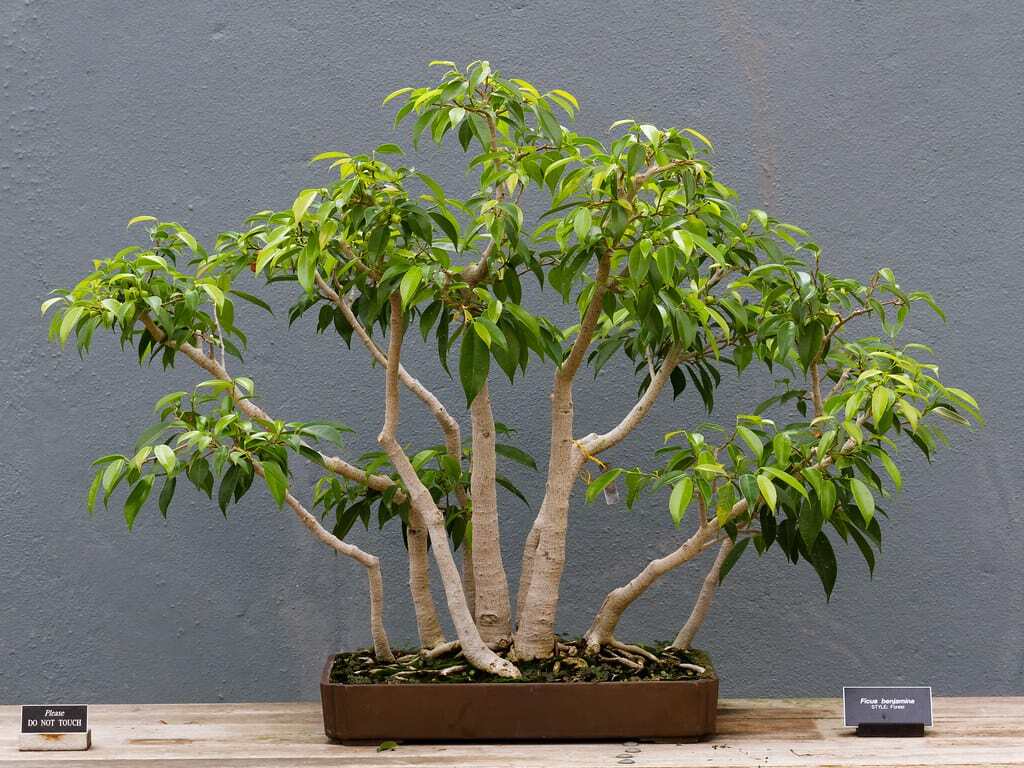
Ficus Benjamina Bonsai
Love ficus trees but looking for something a little smaller? You can actually cultivate Ficus benjamina as a bonsai tree! This is actually a dwarf variety of Ficus benjamina, but it’s relatively easy to find online.
This is actually considered one of the easiest bonsai trees to cultivate. So if you’ve been thinking of dabbling in this art, here’s your starting point!
Other types of ficus trees to try:
Ficus lyrata (fiddle leaf fig)
Ficus lyrata variegata (variegated fiddle leaf fig)
Ficus elastica (rubber tree)
Ficus elastica variegata (variegated rubber tree)
Ficus benghalensis (Ficus audrey)
Other Ficus Benjamina Tips:
- Weeping figs don’t like to be moved and will most likely drop leaves from shock, but they can recover if they are in a spot with good conditions.
- This tree drops leaves when it’s unhappy or stressed.
- This plant is toxic to humans and animals, so be cautious if you have children or pets.
- Weeping figs are susceptible to most of the same pests that can plague fiddle leaf figs, so watch out for spider mites, mealybugs, and other species of scale, gnats, and thrip.
These stunning trees make a statement, clean the air, and provide some gorgeous contrast with your other plants. Give one a try!


